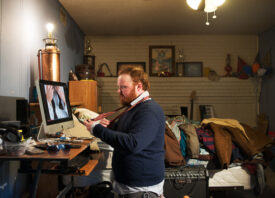Search this site
Thought-Provoking Portraits of Americans in Debt

Debt Portrait #30, Harrison Township, MI 2014
Michele Manis, Housekeeper / Artist, $35,000 in debt. I accumulated this last round of debt after paying off a large amount at 23. I acquired most of the debt when I went back to college. The rest was from mail order catalogs and robbing Peter to pay Paul, or so they say, to get through during times of homelessness.

Debt Portrait #22, Portland, OR 2014
August Golden, 27 years old, non-profit care provider. I am currently about $30,000 in debt from a credit card used to pay for college in California. I have been paying this off slowly and likely will continue for a long time. Or maybe I’ll declare bankruptcy.
For millions of Americans, being in debt is a lonely experience, a circumstance that is kept hidden and negotiated over the phone with anonymous creditors and loan agencies. For Californian photographer Brittany M. Powell, her debt was a call to action. Following the financial crisis of 2008, she lost work, accrued debt, and ultimately filed for bankruptcy. Debt, she explains, has become so stigmatized in our society that it can be easy to forget just how many people are suffering in silence. The Debt Project, in which she photographs people in debt, is her way of illuminating the extent to which this issue affects individual lives as well as the larger framework of our society.
Student loan debt by itself has skyrocketed by 84% since the economic recession, reports CNN, with no end in sight. For the artist, the ways in which we think about debt are firmly rooted in notions of class, government, and personal agency. With a goal of photographing 99 individuals suffering from outstanding debt, Powell makes it resoundingly clear that in our current system, debt can affect almost anyone, regardless of his or her background or age. We spoke her about the project, her personal journey, and what we can do to change the way we think about debt.
To help make The Debt Project a reality, please visit Powell’s Kickstarter.
Could you tell us a bit more about your personal journey with debt after the 2008 financial crisis?
“Sure. I’ve been a freelance, working photographer in the San Francisco Bay Area for 10 years. It was never an easy way to make a living but I had a few years there where I was making it work, and pretty well. In 2008, I had just taken a job working for National Geographic TV on a project as a still shooter and associate producer. I was lucky I had that project to float me through the first year of the recession. When the project ended, I found myself with little to no work. I’d given up a lot of the assisting work I’d still been doing before Nat Geo, and companies and publications were folding left and right. I got a job teaching surf lessons to supplement my income. I lived in a basement room in San Francisco for $500 a month, was on food stamps, and I still racked up in debt what I had lost in income, almost to the dollar. It was just a case of putting bills and gas on my credit cards because I was using all of my cash flow to pay them every month. It felt like I was treading water. It was one of the most stressful times of my life. In 2012, I decided I’d had enough and made the decision to go back to grad school to prepare me to get a teaching position (which I now have). And I knew I would have to file bankruptcy on the $36,000 I had racked up in the three years I was underemployed. As soon as I did that, it was like a huge weight had been lifted, and I was so fascinated by how much shame I had felt about my debt, and how quickly that disappeared. It was in many ways how I had been measuring my own personal success. As soon as I filed, I didn’t see it that way anymore.”

Debt Portrait #1, San Francisco, CA 2013
Danielle Brandon, Hair stylist, $12,324.00 in debt. In my early 20s, I got a credit card to “build credit.” They somehow gave me a $6,000 limit. At the time, I never had money to pay bills and eat, so I decided to buy some new clothes. Why not? Soon that avalanched until I could not pay off my debt at the end of the month. Dental bills, care repair, plane tickets, at times even groceries and gas were put on the card. No matter how I try to chip away, I can never seem to get out from under it. Even though I live a frugal life.
Why do you think debt is so stigmatized in our society?
“I think debt is stigmatized because our society favors wealth. If you come from privilege, then you can pay your debts and the credit system is easy to maneuver. Typically, people go into debt because they need something they don’t have on a basic level: gas and transportation, food, healthcare, money for education, or material goods that we are encouraged to purchase that also help our economy thrive. In a state of Social Darwinism, (which we basically live in) the people who have less are seen as weaker. So if you are operating at a deficit, then a stigma is created…no one wants to consider themselves as lesser or weaker, but when you live in a culture that worships wealth, how can that be avoided? The shame is self-perpetuating and it consistently fuels the stigma.”

Debt Portrait #4, San Francisco, CA 2013
Taylor Nairn, Surveyor and Data Manager for a long-term shoreline monitoring project. $59,636.27 in debt. I got into debt from student loans and being naive about finances— also the fact that we live in a culture that values debt and money more than education and the next generation.”
You write that you felt “naughty” when filing for bankruptcy. Could you expand on this idea of a societal association between debt and morality?
“I was raised to pay back what I owed, live within my means and strive for success. I came from a middle class family with two parents who worked hard and believed that education and hard work doing something you love brings you satisfaction that material wealth does not. When I decided to file bankruptcy, it felt like I was skirting my responsibilities. Historically, debt collectors were looked down upon as much as debtors in society. There was an equal amount of risk associated with loaning the money and of not being able to pay it back — nowadays, not so much, or not in this country at least. Iceland bailed out their citizens in their debt crisis, not its banks, and its economy is on the mend now. Of course they are a much smaller country, but it’s interesting who our system favors. Some say the relationship between debt and morality comes from our country’s Christian and Puritan roots, where in Aramaic, the language spoken by Jesus, the word for “debt” and “sin” are the same. Perhaps it’s ingrained in us to want to live in a sort of moral slavery?”

Debt Portrait #24, Oregon City, OR 2014
Grace Ragland, Family support worker, $75,000 in debt. I began my history of debt when I started college. I was never taught how to handle money, so I spent all my earnings. Going full time to college, I needed the extra money from student loans, so I used the remainder to live off of—pay car loan, etc. When my ex-husband got incarcerated and left me as the sole supporter of the family, I wasn’t able to pay any previous debts. I kept building debt even though I worked 2-3 jobs 7 days a week for 7 years. My heath took a toll and I now have a F.T. job and my kids are older. Starting to see the light at the end—thanks to some help from family and lots of prayer! It affects every part of my life and I wish I had been taught to prioritize handling money.
How did you meet your subjects, and how did you get them to open up about this sensitive topic?
“At first, I met my subjects through word of mouth. I had talked extensively with a few people about how much debt they were in, and they wanted to participate, so the news traveled. There’s no shortage of people who are eligible, just people who are willing and comfortable discussing it. Later, I used craigslist. I posted an ad looking for people in debt for a photo project. This is probably how I’ll continue to reach future subjects, that and by contacting local organizations. To actually sit across from a person one has just met and talk about their finances for an hour is a big deal to a lot of people. I think people opened up because it’s human nature to want to discuss the things that weigh us down. Also, since I have a personal experience with debt, and I was clear about what my intentions were with this project, I think people felt it was a safe place to discuss and stand up to any judgment that might come out about it.”

Debt Portrait #7, Oakland, CA 2013
James Riggs Davidson III (J.R.), Electrical contractor, $52,335.63 in debt. I bought a truck & moved to California where work was scarce. Then decided to go back to school to finish a degree. After graduation, I decided to start my own business & take on more loans needed for equipment & slow times. Within the 2nd year of business, I had to buy new truck due to an accident. By the 3rd year of business, I was making triple payments on most loans so as to pay off quickly… then the economy tanked & my triple payments were barely a single payment due to most lenders ramping their interest rates to cover “losses.”
What has surprised you, if anything, about some of their responses in interview?
“A lot has surprised me, but most of all I think it was how many people really do blame themselves before blaming the system. I was also surprised by how many people are attached to the idea of owning a house. When I interviewed a financial services rep, he told me he saw mortgages as liabilities, and that home ownership in our country is a scam, because banks are the ones who really own the property when a mortgage is involved. I interviewed an anarchist who told me the reason he didn’t want to file bankruptcy was because he feared it affecting his ability to buy a house one day. This added a new layer of curiosity and perspective for me when considering what the modern day American dream is and how we are expected to achieve it in today’s financial system.”

Debt Portrait #8, San Francisco, CA 2013
Mike, Architectural designer, $160,000 in debt. My debt is combined product of a Masters degree, 4 years, a real estate deal, and unemployment.
Could you tell us a bit more about how private student loans work and why they sometimes refuse to set their monthly payments reasonably based on income?
“Private student loans are evil, in my opinion. When you take out an education loan from the government, you are awarded certain loan guidelines specific to that type of loan. Many of these have a fixed interest rate (it won’t change over time). You have the option to defer payment during times of economic hardship, and your repayment amount is based on your income. Lastly, student loans cannot be discharged in bankruptcy. Private student loans basically utilize the same benefits as Federal student loans (the bankruptcy clause) but do not have to follow the same guidelines in terms of interest or repayment. They often refuse to work with the debtor because they don’t have to. It’s pretty common that in order to get private loans down to a more reasonable monthly payment, you have to default on them first, therefore destroying your credit when you are just starting your career.”

Debt Portrait #12, Richmond, CA 2013
Morris LeGrande, Musician, $450,000 in debt. My debt is from a bad mortgage and job loss in 2005.
What is being done at a legislative level to alleviate the weight of debt?
“Elizabeth Warren is a US Senator from Massachusetts who is doing a lot around student loan debt reform. She’s put forward a bill (it got filibustered by the Republicans) to cap the amount of interest the government can charge on loans, and offer low income student loans at the same rate the government loans banks money from the Federal Reserve (0.75%). President Obama has made some changes in his budget to address the student loan crisis as well. The one of note that I think is really great is that low income borrowers’ monthly payments are capped at 10% of their earned income after graduation. All of these ideas are definitely being discussed at a legislative level but, in my opinion, it’s not really enough to solve a mountain of a problem for my generation.”

Debt Portrait #27 Detroit, MI 2014
Mario Garnes, 28 yrs, Tattoo artist / Biker, $40,000+ in debt. I graduated from high school in 2004. I went to Tennessee State University. In 2006, I developed Crohn’s Disease. I had to drop out of school and eventually move back to Detroit, MI. Now I owe for student loans, as well as medical bills. My debt is pretty high due to interest.

Debt Portrait #28, Detroit, MI 2014
Ramon Romero, Age 30. I’ve accumulated over $250,000 in debt. It started from credit cards, phone bills, & a laundromat that I purchased. In 9 months, my water bill was over $28,700.00.
What do you think we can do to change the way we as a society view debt?
“Talk about it. Consider how the debt and credit system works. Don’t be ashamed if you owe creditors money and can’t pay them back. Make the effort, but also recognize, that on a moral level, they took on a risk in issuing a loan in an unstable economy in the first place. It’s important to stay organized. Most people don’t know that once in default, their debts are sold on a secondary market for much less than they owe, so settling should be an option. Strike Debt is a movement that includes organizing a Debt Collective to give debtors a way to organize in order to build power against their creditors. The morality and shame should be left to people and companies who are profiting off the economic hardship so many Americans are facing.”

Debt Portrait #31, Detroit, MI 2014
Bernite Bradley, Community Outreach & Engagement for ESD. I was in debt for $130,000 for homes and cars. I am now still in debt for $26,000 from student loans that helped me live which I was in school. I plan to pay them off one day soon.

Debt Portrait #32, Detroit, MI 2014
Regina Hollis, Parent Partner, AmeriCorps, $30,000. I got into debt because of student loans and letting someone close to me put a car in my name.
All images © Brittany M. Powell


